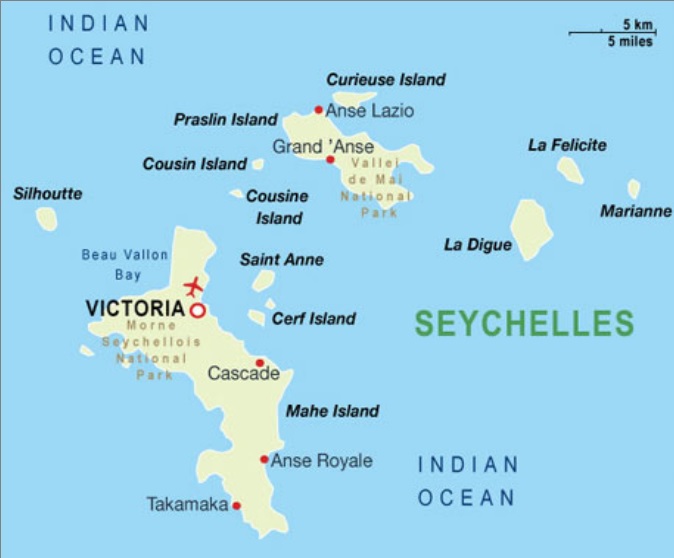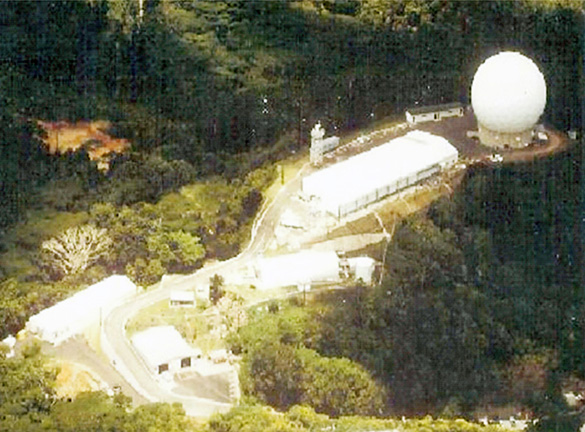Covert meeting in Seychelles revives memories of a planned CIA "false flag" attack BY THE WAYNE MADSEN REPORT
A January 11, 2017 covert meeting in the Seychelles has revived memories of an all-but-forgotten Cold War plan by Central Intelligence Agency-linked mercenaries to attack a U.S. military base and blame it on the Soviets. Reportedly, a clandestine meeting was
arranged on or about January 11 by the Crown Prince of Abu Dhabi between Blackwater founder Erik Prince, representing the Donald Trump transition team, and a Russian government envoy in Seychelles. Prince currently heads up an Abu Dhabi-based mercenary firm, Reflex Reponses (R2), and a Hong Kong-based company also involved with mercenaries called Frontier Services Group. Prince's companies have been involved in civil wars in Yemen, Libya, South Sudan, Somalia, and Syria.
The January meeting between Prince, the brother of Trump's Education Secretary Betsy DeVos, and the Russian representative was reportedly designed to establish a back channel between Trump and Russian President Vladimir Putin. In addition, the Abu Dhabi Crown Prince, Sheikh Mohamed bin Zayed al-Nahayan, was trying to broker a deal with the Trump administration that would see Russia curtail its support for Syria and Iran in exchange for a lessening of Western sanctions against Russia. The Crown Prince reportedly met with key Trump transition figures Jared Kushner and Stephen Bannon in New York in December.
The Russian government denied the Seychelles meeting took place. The identity of the Russian envoy supposedly involved was never disclosed in press reports. Seychelles Foreign Secretary Barry Faure said he was not surprised that such a meeting could have taken place in his nation, adding, "The Seychelles is the kind of place where you can have a good time away from the eyes of the media." It is also a place from which the U.S. Navy, Air Force, and CIA operate MQ-9 Reaper drones, some armed with Hellfire missiles and satellite-guided bombs, in operations in the Horn of Africa.
The Indian Ocean multi-island nation of Seychelles is certainly no stranger to international intrigue. During the Reagan administration, when CIA director William Casey gave the green light for CIA "off-the-shelf" companies to engage in coup plotting and arms and drug smuggling, there were several aborted attempts to overthrow the Seychelles government of President France Albert Rene. One, in 1981, saw South African-based mercenaries led by the noted British-Irish mercenary Colonel "Mad Mike Hoare" attempt to overthrow Rene. Hoare and his mercenary team were working directly for former Seychelles president James Mancham, who was ousted in a 1977 coup by Rene. Hoare and his team masqueraded as drunken tourists but exposed when a rifle was uncovered by Seychelles Customs personnel at the international airport in Victoria on the main island of Mahe. Operation Anvil ended after fighting broke out at the airport. Several Seychelles security personnel were killed along with one of Hoare's team members. Six South African mercenaries were taken prisoner by the Seychelles government.

Hoare and his team managed to commandeer a recently-arrived Air India plane and directed the pilot to fly them to Durban, South Africa. The 1981 coup attempt was directly linked to the South African intelligence services.
The coup also involved Kenyan Attorney General Charles Njonjo and Irish-Kenyan national Bill Parkinson, a former Kenyan Special Branch officer and owner of Kenyan-based airlines, some tied to previous CIA and British MI6 operations in Africa. Parkinson was also known to have significant links to South African intelligence.
Parkinson was involved in the 1981 coup plot against Rene and it was one of Parkinson's aircraft that was to fly exiled Seychelles President Mancham and his cabinet back to Seychelles on the day of the planned coup to resume power after Rene's ouster. Parkinson's Sunbird Aviation Beechcraft 200 was to fly a "Mr. Morgan," an American tourist with a U.S. passport, from Mombasa, Kenya to the Seychelles. "Mr. Morgan" was, in fact, Mancham. The U.S. passport was courtesy of the CIA.
The CIA decided that the South Africans were incapable of ousting the pro-Soviet Rene, and opted to stage its own coup in 1983. A 1982 coup involving South Africa and disgruntled Seychelles military personnel, many of whom disliked the North Korean advisers salted througout their ranks, also failed.
The December 1983 coup plan, signed off by Langley, involved coup plotters assassinating President Rene and launching a "false flag" attack on a U.S. Air Force satellite tracking station, near Victoria International Airport atop La Misere (Poverty) Mountain. The blueprint was a duplicate of the scenario that resulted in the U.S. invasion of Grenada two months earlier. A Marxist coup that overthrew the leftist government of Grenada Prime Minister Maurice Bishop saw U.S. troops invade the island nation to "protect" U.S. medical school students on the island. U.S. forces subsequently expelled Cuban and other Soviet bloc and Libyan personnel from Grenada.
In the case of Seychelles, an attack on the U.S. Air Force facility would result in calls for U.S. military troops to invade and occupy Seychelles, resulting in the expulsion of Soviet, Chinese, North Korean, and East German personnel. According to declassified CIA documents, the scenario in Seychelles would have involved CIA-supported coup plotters potentially killing U.S. Air Force and NASA personnel working at the satellite station. The coup plotters involved two British nationals, a dual British-Zimbabwe citizen, and two French nationals.

In 1983, CIA-backed mercenaries in the Seychelles planned to attack the U.S. Air Force satellite tracking station on Mahe island in a "false flag" attack designed to bring about a U.S. military invasion of the Indian Ocean islands. In the 1960s, there were proposals for the U.S. to buy the Seychelles from Britain and turn the islands into an "Indian Ocean Hawaii."
Today, on the grounds of the satellite station is now found a massive palace built by Sheikh Khalifa bin Zayed al Nahayan, the Emir of Abu Dhabi and President of the United Arab Emirates. The palace is heavily guarded by Gurkha mercenaries from Nepal.
In 1986, there was another coup attempt against the Rene government. Code named Operation Distant Lash, the revolt involved Seychelles Defense Minister Ogilvy Berlouis, 30 mercenaries, and 350 Seychelles citizens, including military personnel.
The 1986 plot against Rene involved his assassination upon his return from the Non-Aligned Summit in Harare, Zimbabwe. While in Harare, Rene was tipped off about the coup plot by Indian Prime Minister Rajiv Gandhi, a summit participant. Gandhi arranged for Rene to be flown back to Seychelles in the Indian Prime Minister's official airplane, "Air India One." In what Indian intelligence dubbed "Operation Flowers are Blooming,” Rene was disguised upon arrival as an Indian woman wearing a traditional sari dress. The coup, like its predecessors, was a failure, as Rene rallied his supporters in the Seychelles capital.
The Seychelles has now drawn the malevolent attention of Prince and his CIA-linked mercenary armies. There is an ironic postscript to the story about the failed Seychelles coups. Before his recent death, Parkinson agreed to sell his Phoenix Aviation Ltd. aircraft company, based at Nairobi's spy-infested Wilson Airport, to Prince's Frontier Services Group. Prince had previously established Phoenix Aviation Malta Limited that is believed to be involved in Libya's civil war.
With Prince's sister Betsy, a Mormon convert and wife of Amway co-founder Dick DeVos, firmly ensconced in Trump's Cabinet and Christian creationist Mike Pompeo in charge of the CIA, Africa should be very wary of "Christian missionary" organizations and their "flying services." In fact, Africa should be doubly-wary of Prince, a convert to the far-right Opus Dei sectarian wing of Roman Catholicism.
